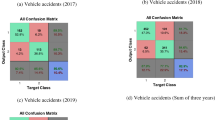Abstract
Road accidents are caused by many factors like alcohol consumption, uncontrolled vehicle speed, poor road surface conditions, bad weather, inadequate traffic signs, and vehicle defects. A single solution cannot address these factors. Therefore, various engineering departments are engaged in road accident studies and their minimization. One of the solutions to study road accidents is to make use of accident prediction models. Regression is one of the essential techniques of predictive analytics in which a lot of prediction problems are modeled. Regression is a kind of supervised learning algorithms since a regression model requires both the dependent as well as the independent variables in the data set. Four simple linear regression models are developed, and two of them are best fitted. The fitted models are logarithmic-linear. The model’s output is to find the number of fatalities based on the total number of accidents. The special cases considered here are accidents on a T-junction and accidents due to the intake of alcohol. A binary logistic regression model is developed for the accidents from the year 2014–2019, and the prediction of causing fatality is computed by using a cut-off probability value of 0.33. The overall model is accepted.
Access this chapter
Tax calculation will be finalised at checkout
Purchases are for personal use only
Similar content being viewed by others
References
Altwaijri S, Quddus M, Bristow A (2012) Analysing the severity and frequency of traffic crashes in Riyadh city using statistical models. Int J Trans Sci Technol 01(04):351–364
Athipathi G, Nagan S, Baskaran T (2017) Accident prediction on national highways in India. Int J Theor Appl Mech 12(01):153–165
Candappa NL, Schermers G et al (2014) Data requirements for road network inventory studies and road safety evaluations- guidelines and specifications. Road Infrast Saf Manage Evaluat Tools 03:1–87
Chandra S, Mohan M (2018) Analysis of driver behavior at unsignalized intersections. J Indian Road Congress 79(02):05–10
Chen F, Chen S (2011) Injury severities of truck drivers in single and multi-vehicle accidents on rural highways. J Accid Analy Prevent 43(05):1677–1688
Fountas G, Fonzone A et al (2020) The joint effect of weather and lighting conditions on injury severities of single-vehicle accidents. J Accid Analyt Methods Accid Res 27:1–19
Goel R (2018) Modeling of road traffic fatalities in India. J Accid Analy Prevention 112:105–115
Haghighattalab S, Chen A, Fan Y, Mohammadi R (2019) Engineering ethics within accident analysis models. J Accide Analy Prevention 129:119–125
Hu W, Donnell ET (2011) Severity models of cross-Median and rollover crashes on rural divided highways in Pennsylvania. J Safety Res 42(05):375–382
Landge VS, Sharma AK (2013) Identifying accident prone spots on rural highways—a case study of national highway No. 58. Int J Chem Environ Biol Sci 01(02):296–299
Martensen H, Dupont E (2013) Comparing single vehicle and multi-vehicle fatal road crashes: a joint analysis of road conditions, time variables, and other driver characteristics. J Accid Analy Prevention 60:466–471
Mendenhall W, Sincich T (2012) A second course in statistics: regression analysis, 7th edn. USA: Pearson Education, Print
Ministry of Road Transport & Highways (2016) Road accidents in India-2019. Government of India, pp 77–99
Ministry of Road Transport & Highways (2019) Road accidents in India-2019. Government of India, pp 15–25
Naqvi HM, Tiwari G (2017) Factors contributing to motorcycle fatal crashes on national highways in India. Procedia Trans Res 25:2084–2097
Qureshi AI, Huang W et al (2020) Mandated societal lockdown and road traffic accidents. J Accid Analy Prevention 146:1–4
Savolainen PT, Mannering F (2007) Probabilistic models of motorcyclists injury severities in single and multi-vehicle crashes. J Accid Analy Prevention 39(05):955–963
Singh SK (2017) Road traffic accidents in India: issues and challenges. Trans Res Procedia 25:4708–4719
Tay R, Barua U, Kattan L (2009) Factors contributing to hit and run in fatal crashes. J Accid Analy Prevention 41(02):227–233
Theofilatos A, Graham D, Yannis G (2012) Factors affecting accident severity inside and outside urban areas in Greece. J Traffic Injury Prevention 13(05):458–467
Valen A, Bogstrand ST, Vindenes V, Frost J, Larsson M, Holtan A, and Gjerde H (2019) Driver-related risk factors of fatal road traffic crashes associated with alcohol or drug impairment. J Accid Analy Prevention 131:191–199
Wegman F (2017) The future of road safety: a worldwide perspective. J IATSS Res 40:66–71
Yannis G, Dragomanovits A et al (2016) Use of accident prediction models in road safety management: an international inquiry. Trans Res Procedia 14:4257–4266
Acknowledgements
The authors wish to thank the Civil Engineering Department, College of Engineering Pune, for giving the opportunity to do research. Also, extremely grateful to Local Police stations Pune City, Ministry of Road Transport and Highways for providing data used in this study.
Author information
Authors and Affiliations
Corresponding author
Editor information
Editors and Affiliations
Rights and permissions
Copyright information
© 2023 The Author(s), under exclusive license to Springer Nature Singapore Pte Ltd.
About this paper
Cite this paper
Mhetre, K.V., Thube, A.D. (2023). Development of Road Safety Models by Using Linear and Logistic Regression Modeling Techniques. In: Ranadive, M.S., Das, B.B., Mehta, Y.A., Gupta, R. (eds) Recent Trends in Construction Technology and Management. Lecture Notes in Civil Engineering, vol 260. Springer, Singapore. https://doi.org/10.1007/978-981-19-2145-2_89
Download citation
DOI: https://doi.org/10.1007/978-981-19-2145-2_89
Published:
Publisher Name: Springer, Singapore
Print ISBN: 978-981-19-2144-5
Online ISBN: 978-981-19-2145-2
eBook Packages: EngineeringEngineering (R0)




